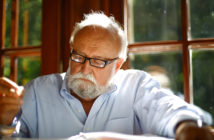An interview with Professor Jacek Purchla, President of the Polish National Commission for UNESCO and Chairperson of the 41st session of the World Heritage Committee., director of the International Cultural Centre.
• From 2 July, 2017 you will be chairing the 41st session of the UNESCO World Heritage Committee in Krakow, which will be attended by 2,000 participants. For almost a quarter of a century you have observed Kraków’s Main Market Square, the centre of the city’s urban planning inscribed to the first World Heritage List in 1978, from the windows of your director`s office at the International Culture Centre. Taking both these into consideration, what is in your opinion the highest value of heritage conservation today?
• I am convinced that the Convention Concerning the Protection of the World Cultural and Natural Heritage of 1972 gave us all the unique opportunity to discover the often hidden value in geographically distant cultural regions. Such was the value of Kraków in 1978, hidden behind the Iron Curtain in a different political reality, where it was experiencing an ecological disaster and considerable poverty by European standards, as well as a civilizational collapse. Today, 40 years after the city was inscribed to the first World Heritage List, Kraków is in a completely different moment in its history and in a different place as far as our thinking about cultural heritage and its conservation is concerned. Surprisingly, it turns out that its greatest threat is not industrial pollution, but the 12 million tourists from all over the world who come here every year. This early inscription, however, demonstrates very well the value of the idea of world heritage, which obliges us to treat such special places not only as the common heritage of humanity, but also as a shared responsibility with regard to their preservation.
• What is the meaning of the fact that those who make decisions about the protection of world cultural heritage are meeting here?
• Poland was one of the first signatories to the Paris Convention when it acceded to the agreement in 1976. Previously, however, Polish experts were very active in the drafting of the document. Despite this, it has taken 40 years for Poland to be invited to host the Committee’s session – an extraordinary event that brings together the world’s leading players in the protection of cultural and natural resources. The participants of the session will have to consider a vast number of important issues. And they will be discussed in Kraków, which since the first half of the 19th century has been a Polish laboratory for heritage protection. So, we will have a dual role, that of the host of the meetings, but also that of an arbiter in what are often very difficult debates related to world heritage. We will also be able to share our special experience in many different fields.
• You are meeting when treasures that are part of the human cultural heritage are being destroyed as spectacularly as in Palmyra and Aleppo, as well as in the mountains of Afghanistan. Did you think 40 years ago that it would be necessary to create a list of heritage which is endangered?
• In the first list that was published in 1978, heritage in danger sites were also included. For instance, Kraków, where acid rains were dissolving the walls of priceless monuments. It is true that the intention of the initiators of the list was to determine criteria that could describe the unique yet universal value of places scattered across the world. About a hundred such places were taken into account then. Today, we have a list of 1,052 entries. For over 40 years, we have created very strict criteria not only for determining the value of the various monuments, but also with regard to the requirements imposed on governments in order to preserve them. The authorities of different countries generally comply with our regulations. Unfortunately, there are also special situations that have forced the World Heritage Committee to create a special List of World Heritage in Danger, which includes 55 sites. Their geographical location is in the main linked to a map of the military conflicts in the world, such as, Syria, Iraq, and Libya, but there is also Kathmandu, which was seriously destroyed by a recent earthquake, and a site one would not expect to see on the list – Liverpool. The problem there is modernization, which is threatening the historic docklands. There are so many hazards, but I believe the Kraków meeting will not fail to address the most significant: Palmyra and Aleppo. Naturally, UNESCO cannot be expected to start carrying out on-site conservation work immediately, but it is time groups were sent to where these disasters have taken place and for international solidarity to be organized. And this will surely be dealt with in Kraków. All the more so that the Poles can share their own very important experiences. The Warsaw Old Town, which was completely destroyed by the German occupiers in 1944 and reconstructed after the war, has been on the World Heritage List since 1980. Its inscription to the list signified recognition of the determination, and also the precedent, to reconstruct a city, a fact which is worth remembering today when we think of Aleppo, where 60% of the historic centre has been reduced to rubble.
• How has extending the UNESCO list changed your thinking about world heritage which you have been dealing with from various perspectives for a very long time?
• The fact that there are over a thousand entries teaches humility and in a way relieves the reflexive eurocentrism. Since the 19th century our continent has had a monopoly on the thinking about the past in terms of monuments, as well as on the first great conservation work, the archaeological explorations, and also deciding what in the civilizations of other continents can be considered valuable from a global perspective. My humility, which increases with each new entry on the list, is accompanied by the experience of discovering the value of the “other” in Asian and Pacific countries, in Latin America, and North Africa. The list now includes excellent examples of natural heritage, but it has also greatly expanded my understanding of the work of man. After all, there are not only medieval cathedrals, urban settings and royal palaces listed, but often unusual and extraordinary works created by the skill of humans across different disciplines. There are entries documenting technological progress and the first such example on the list was the seven-hundred-year-old Salt Mine in Wieliczka. Its income in the past was used to develop nearby royal Kraków.
![]()
Dziedzictwo to nasz wspólny obowiązek
Rozmowa z prof. Jackiem Purchlą, przewodniczącym Polskiego Komitetu do spraw UNESCO, przewodniczącym 41. sesji Komitetu Światowego Dziedzictwa oraz dyrektorem Międzynarodowego Centrum Kultury.
• Od 2 lipca poprowadzi Pan 41. sesję Komitetu Światowego Dziedzictwa UNESCO, na którą przyjedzie do Krakowa ok. 2 tysiące uczestników. Jednak od ćwierć wieku patrzy Pan codziennie ze swego gabinetu dyrektora Międzynarodowego Centrum Kultury na krakowski Rynek Główny, czyli epicentrum układu urbanistycznego miasta, który w 1978 roku znalazł się na pierwszej Liście Światowego Dziedzictwa. W czym z tej perspektywy widzi Pan dzisiaj najważniejszą wartość idei ochrony światowego dziedzictwa?
• Jestem przekonany, że Konwencja w sprawie ochrony światowego dziedzictwa kulturalnego i naturalnego z 1972 roku dała nam wszystkim niezwykłą szansę odkrywania dla świata wartości często ukrytych w odległych od siebie kręgach kulturowych. Taką wartością był Kraków, w 1978 roku, schowany za żelazną kurtyną w innej rzeczywistości politycznej, przeżywający katastrofę ekologiczną, głęboką jak na Europę biedę i zapaść cywilizacyjną. 40 lat od znalezienia się na tej pierwszej liście Kraków jest w zupełnie innym miejscu swojej historii i w innym punkcie naszego myślenia o dziedzictwie i jego ochronie. Największym zagrożeniem nie są zanieczyszczenia przemysłowe, a 12 milionów turystów z całego świata, którzy tu co roku przyjeżdżają. Ten wczesny wpis świetnie pokazuje jednak wartość idei światowego dziedzictwa, która wzywa nas do potraktowania takich szczególnych miejsc nie tylko jako wspólne dziedzictwo ludzkości, ale i wspólną odpowiedzialność za pomoc dla ich zachowania.
• Co dla Pana oznacza fakt, że ludzie, którzy decydują o ochronie dziedzictwa na całym świecie spotykają się właśnie tutaj?
• Polska była jednym z pierwszych sygnatariuszy konwencji paryskiej. Przystąpiła do niej już w 1976 roku. Wcześniej polscy eksperci bardzo aktywnie uczestniczyli w tworzeniu jej projektu. Po 40 latach doczekaliśmy momentu, kiedy Polska po raz pierwszy jest gospodarzem sesji Komitetu – tego niezwykłego wydarzenia, które co roku skupia najważniejszych światowych graczy zajmujących się ochroną zasobów kulturowych i przyrodniczych. Na uczestników sesji czeka maraton ważnych spraw. Będziemy je rozstrzygać w Krakowie, który jest od I połowy XIX wieku polskim laboratorium myśli konserwatorskiej. Wystąpimy więc jako gospodarz obrad, ale i arbiter w często bardzo trudnych sprawach dotyczących światowego dziedzictwa. Będziemy też mogli podzielić się naszym, szczególnym w wielu aspektach doświadczeniem.
• Spotykacie się, gdy skarby ludzkiego dziedzictwa są niszczone tak spektakularnie jak w Palmyrze i w Aleppo, jak w górach Afganistanu. Czy 40 lat temu dopuszczał Pan myśl, że potrzebne będzie tworzenie listy zagrożonego dziedzictwa?
• Kiedy w 1978 roku pierwsza lista była ogłaszana, znajdowały się na niej także obiekty zagrożone, jak właśnie Kraków, w którym kwaśne deszcze wręcz rozpuszczały mury bezcennych zabytków. To prawda, że intencją inicjatorów listy, było znalezienie wspólnego mianownika, który potrafi opisać wyjątkową powszechną wartość miejsc rozsianych na całym świecie. Mówiono zresztą wtedy o setce takich miejsc… Dzisiaj mamy na liście 1052 wpisy. Przez 40 lat jej funkcjonowania stworzyliśmy bardzo rygorystyczne kryteria dotyczące nie tylko określania wartości obiektów, ale i wymogi nakładane na rządy państw w celu zachowania tego dziedzictwa. Władze na ogół z tego obowiązku się wywiązują. Ale są też sytuacje szczególne, które zmusiły Komitet Światowego Dziedzictwa UNESCO do stworzenia specjalnej Listy Zagrożonego Dziedzictwa. Mamy na niej obecnie 55 miejsc. Ich geografia wpisuje się przede wszystkim w mapę konfliktów militarnych toczących się w świecie z Syrią, Irakiem, Libią… Ale mamy na niej też Katmandu zniszczone przez niedawne trzęsienie ziemi i miejsce, którego obecność tutaj może zaskakiwać – Liverpool. Tam niebezpieczna okazuje się presja modernizacyjna zagrażająca zabytkowemu nabrzeżu portowemu. Zagrożeń jest więc wiele, ale myślę, że nasze krakowskie spotkanie nie może ominąć najdramatyczniejszych: Palmyry i Aleppo. Od UNESCO trudno oczekiwać natychmiastowego zainicjowania na miejscu prac konserwatorskich, ale na wysyłanie misji na miejsce tych katastrof, organizowanie międzynarodowej solidarności z całą pewnością jest już czas. I na pewno się tym zajmiemy w Krakowie. Tym bardziej, że Polacy mogą się tu dzielić bardzo tu ważnymi doświadczeniami. Od 1980 roku na Liście Światowego Dziedzictwa znajduje się starówka w Warszawie. W 1944 roku została zniszczona przez niemieckich okupantów, a po wojnie zrekonstruowana. Wpisanie jej na listę było docenieniem determinacji i precedensu odbudowy wartym przypomnienia dzisiaj, gdy myślimy o Aleppo, którego historyczna część została w 60 proc. obrócona w gruzy.
• Jak poszerzanie listy UNESCO zmieniło Pańskie myślenie o światowym dziedzictwie, którym zajmuje się Pan z różnych perspektyw od bardzo dawna?
• Te ponad tysiąc wpisów uczy pokory i łagodzi odruchowy europocentryzm. Od XIX wieku nasz kontynent miał monopol na myślenie o przeszłości w kategoriach zabytku, na pierwsze wielkie prace konserwatorskie, poszukiwania archeologiczne, na decydowanie o tym, co z cywilizacji innych kontynentów można uznać za wartościowe w perspektywie globalnej. Tej mojej rosnącej z każdym wpisem pokorze towarzyszy doświadczenie odkrywania wartości „innego” w krajach Azji i Pacyfiku, w Ameryce Łacińskiej, Północnej, Afryce. Ta lista obejmuje znakomite przykłady dziedzictwa stworzonego przez przyrodę, ale też niezwykle poszerza także moje rozumienie dzieła człowieka. Przecież są na niej nie tylko średniowieczne katedry, układy urbanistyczne i pałace królewskie, ale często niezwykłe wytwory ludzkiego talentu w bardzo różnych dyscyplinach. Pojawiają się też wpisy dokumentujące postęp technologiczny. Jako pierwszy taki obiekt na listę trafiła siedemsetletnia Kopalni Soli w Wieliczce. Tej, z której dochody budowały kiedyś pobliski, królewski Kraków.









